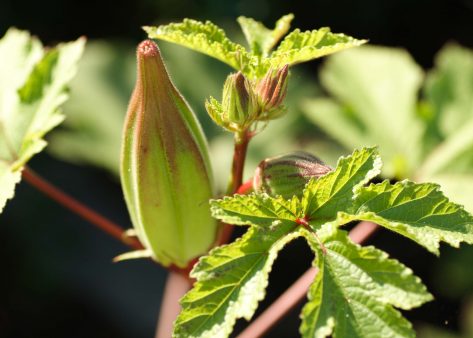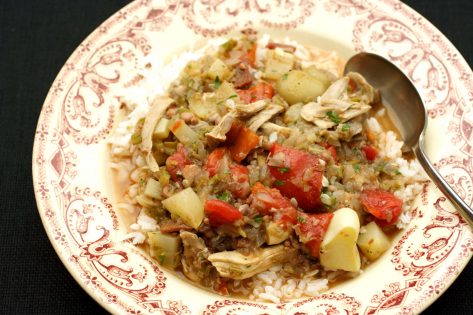Okra—Now and Then, Again
It was inevitable that I would to learn to how to prepare okra right about now. But that’s exactly how I knew it would be back when I planted okra seeds in my garden plot earlier this summer. That’s one of the great things about having a garden: it forces you to deal. If there is a vegetable you want to become familiar with in the kitchen, plant it in your garden. A pot in a courtyard or on a balcony will do just as well. Then, weeks, maybe months, later, the vegetable will have migrated from the soil to your kitchen counter, and finally into one of your cooking pots.
You may or may not have had ideas for the preparation of the vegetable when you planted it, and even if you did, a lot can happen along the way from seed to produce. I had pickles in mind when I planted my seeds, and, for that reason, of the two heirloom varieties I planted, Cajun Jewel and Hill Country Red, I was especially excited about the latter, described as “perfect for pickled okra” in the seed catalog.
But by harvest time, getting the canning equipment down, sterilizing the jars, and doing all that goes into canning, including heating up the kitchen during humid, ninety-degree-plus days, suddenly seemed overwhelming. I devised a new plan that went in two opposite directions: to an au courant preparation and to a very, very, old preparation. Both preparations resulted in completely slime-free okra, and that is worth saying because the sliminess of okra seems to be the main complaint about this otherwise likeable and exceptionally nutritious vegetable.
The of-the-moment preparation I tried, and can recommend, is to take young okra, ideally not much longer than your pinky, slice them in half lengthwise, season them with salt and pepper (and other seasonings if you like), toss them with oil, and roast them at a high heat (about 425°F) in the oven just until tender and browned. I first ran across this method in a cookbook manuscript I edited earlier this summer, then, just last week, the owner of my local butcher shop told me that of late she had been preparing okra in the same way, using the roasting method. I figure when something comes up more than once, in a relatively short time, it must be a “thing.”
Mary Randolph’s recipe for “Ochra Soup, the second prong in my two-fold prep plan, is definitely not a thing this okra season, though it was, presumably, in 1824, when it was published in her book, The Virginia Housewife. This book is considered to be the first truly American cookbook and first regional one (in this case Southern) because Randolph included new American dishes that reflected the culinary contributions and traditions of the different nations of people who came to America, either by force or of their own will, and the nations of people who predated the rest of us—the Native Americans. Because okra came to the colonies with African slaves, and is associated with Southern cooking, I was sure I’d find an okra recipe in The Virginia Housewife.
A disappointing look in the “Vegetables” section of the contents turned up nothing, however. I’d set the book aside and had begun to ply my other southern cookbooks for ideas, when I leafed through the contents once more, not wanting to think this seminal Southern cookbook was lacking in an okra recipe. Then I noticed a recipe for “ochra soup” in the short soup section at the beginning of the book. Old-fashioned spelling is just one of the challenges of cooking from “receipts,” but part of the fun, too (if you like detective work). Had I done the obvious thing to start—that is, done an online search for “Mary Randolph okra recipe”—her ochra soup recipe would have come up straightaway, but I would have missed the sense of discovery. Eventually I did do that, and that’s how I learned there is yet a second okra recipe in The Virginia Housewife: it is a stewed recipe called Ochra and Tomatoes and is deposited in a short, easy-to-overlook “Dishes for Lent” section at the back of the book.
Randolph’s ochra soup takes some time to pull off: if the au courant roasting method is the hare, the soup is the tortoise. But it’s worth doing. Simply seasoned, with just salt and pepper, the resulting soup is hearty, comforting, and full of rounded, deep flavors that taste of the ingredients used. And the broth, where the co-mingling of all those flavors happens, is particularly delicious.
Come to think of it, on this first day of autumn, Randolph’s recipe is just the thing for right now, when you need a seasonal bridge—something to make use of the last of this summer’s pre-frost harvest, just as the hottest of the hot weather has broken and the thought of hot soup can be entertained.
* * * * * * * * * * * * * * * * * * * * * * * * * * * * * * * * * * * *
The recipe:
First, I’ll give you Mary Randolph’s recipe, verbatim, followed by my adaptation of it.
Ochra Soup (from The Virginia Housewife)
Get two double handsful of young ochra, wash and slice it thin, add two onions chopped fine, put it into a gallon of water at a very early hour in an earthen pipkin, or very nice iron pot; it must be kept steadily simmering, but not boiling; put in pepper and salt. At 12 o’clock put in a handful of lima beans; at half-past one o’clock, add three young cimlins cleaned and cut in small pieces, a fowl, or a knuckle of veal, a bit of bacon or pork that has been boiled, and six tomatoes, with the skin taken off; when nearly done, thicken with a spoonful of butter, mixed with one of flour. Have rice boiled to eat with it.
Okra Soup (adapted from The Virginia Housewife)
Once I got past my slight spelling hiccup with “ochra,” I had to decipher the “three young cimlins” listed in Randolph’s recipe (above). They are what most of us today call “pattypan squash,” or “scallop squash.” They are an heirloom Native American squash, and Randolph’s use of them, in combination with African okra, makes for a true born-in-America recipe. I found pattypan squash as recently as last weekend at my local farmer’s market. If you can’t find it, use an equivalent amount by weight of another variety of young summer squash, the smaller the squash the better. Because there’s not a lot of seasoning going on in this soup, I used ¾ teaspoon of black pepper, which makes a noticeably peppery soup, but not so much that it’s peppery hot. You will likely need to add more salt to taste at the end; to taste good, this soup needs to be well seasoned. I’ve interpreted Randolph’s recipe as closely as I could; the only personal touch I introduced is some chopped fresh parsley, added toward the end of cooking.
Randolph gives the option of using veal knuckle instead of fowl, and you can give this a try, if you like. I leave its preparation up to you. For now, I decided to limit my learning curve to pipkins, cimlins, and beurre manie; I’ll save learning how to cook veal knuckle, or perhaps baby beef knuckle, for another day.
10 ounces young okra, washed and thinly sliced
2 medium onions, finely chopped
1¼ teaspoons fine sea salt, divided
¾ teaspoon freshly ground black pepper
½ cup fresh (or frozen) shelled lima beans
6 tomatoes (about 2¾ pounds), skinned, seeded, and coarsely chopped (with juices), or 1 (28-ounce) can diced tomatoes (with juices)
3 small pattypan squash (about1 pound), diced
2 pasture-raised bone-in chicken leg quarters (about 1½ pounds)
2 thick-cut slices bacon, blanched in boiling water for a minute
⅓ cup finely chopped fresh flat-leaf parsley (optional)
For the beurre manié:
1 tablespoon butter, softened
1 tablespoon all-purpose flour, preferably Southern A-P flour (see Note)
For serving:
Boiled long-grain rice, preferably “Carolina Gold” or basmati (see Note)
- Put the okra and onions in a large enameled Dutch oven, ceramic stewpot, or other heavy bottom soup pot. Cover with 1 gallon of water, season with 1 teaspoon of the salt and the pepper, and bring to a gentle boil over high heat, then lower the heat and keep at a steady simmer for 3 hours, uncovered; do not boil. Add the limas and cook until tender, 35 to 40 minutes.
- Add the tomatoes, squash, leg quarters, bacon, and remaining ¼ teaspoon of salt to the pot. Bring back to a simmer over medium-high heat, then reduce the heat and simmer, with the lid of the pot placed askew, until the chicken is cooked through and falling off the bone, about 1 hour. Pull the pot off the heat and remove the chicken quarters and bacon and set them aside to cool until you can handle them. Remove the meat from the bones and shred it, then remove the fat from the bacon and roughly chop the bacon meat. Return the shredded chicken and any juices and the chopped bacon to the pot and add the parsley, if desired. Bring the soup back to a simmer over medium-low heat.
- Make the beurre manié: Knead the butter and flour together in a small bowl with your fingers to form a smooth paste. Use a whisk to scoop up a small amount of the beurre manié and whisk it into the simmering soup. Repeat until all of the beurre manié is used. After adding the beurre manié, simmer for another minute or so. Taste for seasoning and correct as needed.
- Serve the soup over rice. Serves 8.
* * * * * * * * * * * * * * * * * * * * * * * * * * * * * * * * * * * *
Notes: Southern all-purpose flour is traditionally made with soft winter wheat and has a lower protein content than all-purpose flours available in other part of the country. The lower the protein content, the higher the starch content, and more starch means more thickening ability. You can use any all-purpose flour to make the beurre manié, but if you want to use a flour closer to what Randolph would have likely used, go for a Southern brands of all-purpose flour, such as White Lily.
Any type of long-grain rice will do, but if you’d like to recreate a taste as close as possible as what Mary Randolph had in mind, try Carolina Gold Rice. It is pricey, but is an exceptionally flavorful and aromatic rice that cooks up perfectly every time. If you haven’t tried it, once you do, you will understand why it was once renowned around the world and thought of as “gold” by the plantation owners who made it their cash crop of choice. In my opinion, a good-quality basmati rice is the next best substitute.
Here are some places to buy Carolina Gold Rice (click here and here).


